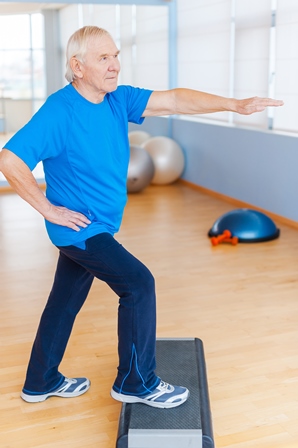
When you think of exercise do you visualize young, fit bodies participating in vigorous athletics and fitness activities? Do you picture young men and women breaking a sweat, pushing their limits, and working hard in pursuit of the perfect body or enhanced sport performance? While that image certainly represents a percentage of those individuals that exercise, it isn’t a comprehensive image. The fact is that many older adults participate in fitness training. While they too might enjoy pursuing their ideal body or improved performance on the field of play, they may be training for the many other benefits that can result from participation in a fitness program.
So what benefits can an older adult receive as a reward for exercising? There are several! It should be noted that a comprehensive fitness training program incorporates several different types of exercise, which can include resistance training, aerobic endurance training, flexibility training, and balance training. When put into practice, these can help make activities of daily living (such as keeping up with grandchildren), maintaining independence and mental sharpness, and staying out of pain much easier.
Resistance training, also referred to as strength training or weight training, certainly offers benefits to older adults. Lloyd and Faigenbaum (2016) have stated that, “Significant improvements in muscular strength, muscular power, muscle mass, bone mineral density, and functional capabilities (e.g., gait speed) have been observed in older people who participated in progressive resistance training programs” (p. 150). In addition, Lloyd and Faigenbaum assert that, “Aerobic, resistance, and balance exercise are beneficial for older adults, but only resistance training can increase muscular strength, muscular power, and muscle mass” (p. 151). Westcott and Faigenbaum (2012) have stated that, “Resistance training has been shown to reduce the risk of several degenerative problems that are common to older adults, including sarcopenia, osteopenia, high blood pressure, unfavorable blood lipid profiles, insulin sensitivity, delayed gastrointestinal transit, low back pain, and metabolic syndrome” (p. 473).
Participation in aerobic endurance training has long been encouraged as a means to enhance one’s fitness (Lloyd and Faigenbaum, 2016, p.151). This shouldn’t be a surprise. Some established benefits of aerobic endurance training include improvements in cardiorespiratory fitness, increases in caloric utilization, reduced disease risk, improvements in sleep, and improved digestion (Westcott and Faigenbaum, 2012, pp. 470-471).
Flexibility training can also benefit older adults. Jeffreys (2016) has stated that, “Older people undergo a process called fibrosis, in which fibrous connective tissue replaces degenerating muscle fibers” (p. 321). He identifies the likely culprits for this degenerative change as a lack of physical activity and how older adults tend to utilize less of their available range of motion in their movements. However, older adults can take some reassurance from his claim that flexibility can be improved in older adults with proper physical training (Jeffreys, 2016, p.321).
Balance training is of particular interest to older adults due to its role in falls-prevention efforts. Lloyd and Faigenbaum (2016) have stated that, “…it would appear that balance and flexibility training must accompany resistance training in order to provide the requisite training stimulus to reduce fall risk” (p. 150).
While certainly not a comprehensive list of potential benefits from exercise, those benefits identified above may provide compelling reasons for the older adult to take part in a fitness routine. The same could be said for the young adult that wishes to age gracefully.
The CORE program at Raleigh Orthopaedic offers the opportunity to train under the guidance and supervision of educated and experienced fitness specialists and rehabilitation professionals. This provides participants, young and old alike, with a safe introduction to fitness training so that they can reap the benefits offered by exercise. Learn more about the Core Program.
References:
Jeffreys, I. (2016). Warm-up and flexibility training. In G.G. Haff and N.T. Triplett (Eds.), Essentials of strength training and conditioning (4th ed., pp. 317-350). Champaign, IL: Human Kinetics.
Lloyd, R.S. and Faigenbaum, A.D. (2016). Age- and sex-related differences and their implications for resistance exercise. In G.G. Haff and N.T. Triplett (Eds.), Essentials of strength training and conditioning (4th ed., pp. 135-154). Champaign, IL: Human Kinetics.
Westcott, W.L. and Faigenbaum, A.D. (2012) Clients who are preadolescent, older, or pregnant. In J.W. Coburn and M.H. Malek (Eds.), NSCA’s essentials of personal training (2nd ed., pp. 465-487). Champaign, IL: Human Kinetics.
About Greg Maness, MS, CSCS:
Greg Maness is a fitness specialist with the CORE program at Raleigh Orthopaedic. He earned his Master of Science degree in Exercise Science and Health Promotion (Performance Enhancement and Injury Prevention) from California University of Pennsylvania in 2007. He earned his Bachelor of Arts degree in Exercise and Sport Science from East Carolina University in 2001. Greg has worked in the health / fitness / sport performance field for over five years. Prior to joining the CORE program team as a fitness specialist in March 2017, he worked as a personal trainer and as a sport performance coach. Greg has participated in a variety of sports and physical activities. As an adult, he has competed as a member of baseball and ice hockey teams. He has also competed in the sport of weightlifting. In addition, Greg also enjoys listening to music, reading, traveling, and watching movies and sports.